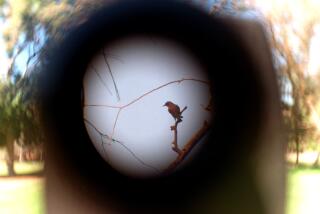Looking at the clouds in a better light
- Share via
As metaphors, clouds are almost never good things. There are clouds of suspicion, clouds of anger, clouds on the horizon, cloudy judgments. Clouds loom, darken, threaten, menace. Clouds get in the way of our tan. Oh, we do not like clouds.
And with them, of course, there’s the rain: the tears of a cloud that wash out weddings, poison picnics, send us all running for cover. Keep on the sunny side of life, the song tells us, for the clouds and storm will in time pass away.
If ever a feature of nature was ripe for a PR makeover, clouds are it.
Enter Gavin Pretor-Pinney, a deliciously wry writer whose book “The Cloudspotter’s Guide” (Perigree, $19.95) just may rescue clouds from ignominy -- or at least get us to look up as they slip by, ever-changing, right over our very noses. Published earlier this year in the United Kingdom and just this summer in the United States, the 38-year-old Englishman’s treatise has been a surprise hit -- at least in Great Britain, where it rests comfortably among the top-10 nonfiction titles. Never mind the silver lining. It turns out the cloud is the thing.
Delving deep into cloud science, but also the associated lore, literature, art, history and religion, Pretor-Pinney provides a thoroughly readable narrative about the wonderful “expressions of the atmosphere’s moods that can be read like those of a person’s countenance.” Clearly these lofty masses of millions of water droplets and ice particles can bring out the poet and philosopher in one.
For Pretor-Pinney, it all started as a bit of a lark. A friend who knew of his peculiar fascination asked him to talk on the subject at a literary festival. Fearing that no one would show up, he declared the talk “the inaugural lecture of the Cloud Appreciation Society.” It was a burst of meteorological genius that helped fill the room for the lecture. Not only did people show up, they wanted to join the society -- a society that, oh right, didn’t actually exist.
Amazed by the response, Pretor-Pinney wasted little time creating a real Cloud Appreciation Society, where the only requirements for membership are about $6 and a shared desire to “fight the sun fascists and their obsessions with ‘blue-sky thinking.’ ” The online society (www.cloudappreciationsociety .org) has made a global village of out-of-the-closet cloud lovers from 40 countries. So far, more than 5,000 members have signed up.
Soon, new members were contacting Pretor-Pinney asking him to recommend books on clouds. Finding only coffee table books or rigorous scientific journals, he decided to write his own.
“It just seemed weird to me that there wasn’t a book for the general reader about this subject, which, when I talk to people about it, everyone has something to say,” he said in an interview. “There’s that universal relationship with clouds, whether people like them or hate them.”
After 28 publishers rejected his book proposal (he still has the rejection letters), one finally took the bait.
Pretor-Pinney says his book and burgeoning society are rekindling a fondness for clouds that is cultured in childhood and then gradually tamped down as we grow older.
“There’s something established in people, a connection with clouds when they’re young, and then it gets buried or goes dormant,” he says. “I think one reason why the book has been this surprise hit is that it has reawoken that childhood interest.”
Aside from simply appreciating clouds, Pretor-Pinney wants us to understand them. He wants us to know, for instance, that a mature full-size cumulonimbus cloud is estimated to contain the energy equivalent of 10 Hiroshima-sized bombs. And that there is growing evidence that jet contrails, “the bastard son of the cloud family,” are having a significant warming effect on ground temperatures. And that whether a cloud produces precipitation depends on the size of the water particles.
Though his lucid descriptions of clouds meet scientific rigor, Pretor-Pinney is not above resorting to more colorful language. As when he describes the puffy stratocumulus as looking “like someone couldn’t find the ‘off’ switch on the cotton candy machine.” A nimbostratus, he tells us, “won’t be winning any cloud beauty contests.”
“I was trying with the book to get people to look at something that was so familiar, but to just try and think about it in a slightly different way,” Pretor-Pinney says. “And that’s a kind of shift that I think can happen. They look up and these clouds have been there the whole time, but they look up and go, ‘Wait a minute, they are incredibly beautiful and I never really stopped to think about it.’ ”
More to Read
Sign up for our Book Club newsletter
Get the latest news, events and more from the Los Angeles Times Book Club, and help us get L.A. reading and talking.
You may occasionally receive promotional content from the Los Angeles Times.







